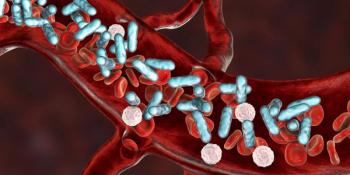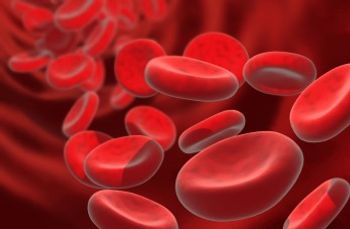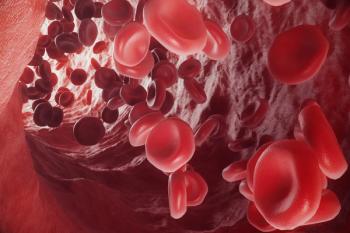
- ONCOLOGY Vol 26 No 3
- Volume 26
- Issue 3
Lymphedema Prevention and Early Intervention: A Worthy Goal
The etiology and risk factors of breast cancer–related lymphedema (BCRL) are multifactorial and not fully understood.
The etiology and risk factors of breast cancer–related lymphedema (BCRL) are multifactorial and not fully understood. BCRL risk factors are divided into three main categories. There are treatment-related factors, including surgery, radiotherapy, chemotherapy, and combined treatments. Secondly, there are disease-related factors, including tumor stage at time of diagnosis, pathologic nodal status, number of removed lymph nodes, and the location of the tumor in the breast. Finally, there are patient-related factors, including age at diagnosis, high body mass index (BMI), comorbidities, history of infection or inflammation, hand dominance, sedentary lifestyle, and excessive use of the affected limb.
BMI is one of the patient-related factors affecting BCRL. Several studies showed that a majority of the patients with BCRL were overweight or obese. BMI is a risk factor for increased severity of BCRL, infection, and wound healing. Advanced age also appears to be a risk factor that contributes to the severity of BCRL and quality of life. Further validation studies must be conducted to obtain more information about the effects of the patient’s age on BCRL.[1,2]
Level of hand use is another significant factor for BCRL, notwithstanding controversy in the literature. Two studies from our group confirmed that patient occupation is a risk factor for BCRL.[3,4] We modified the previous classification system of the level of hand use by three objective criteria, according to the status of occupational workload. Group I included working continuously less than 30 minutes at a time and 8 hours or less per day. Group II included working continuously between 30 and 60 minutes at a time, and 8 hours or less per day. Group III included working continuously for more than 1 hour and at least 8 hours per day. Based on this new classification, we confirmed that occupation is an important risk factor for increased severity of BRCL, and patients with occupations requiring more upper extremity activity and long periods of work had an independent risk for more severe disease outcome. Therefore, patients with BCRL should be advised to adjust their daily use of upper extremities to prevent increased severity of BRCL. As the study authors stated, a uniform definition of lymphedema does not exist and the diagnosis of BCRL remains a challenge. Nevertheless, the new techniques for diagnosis of lymphedema, including DEXA (dual emission x-ray absorptiometry) and BIS (broadband impedence spectroscopy), are promising. Such technologies represent significant improvements over traditional ones, by providing standardized cutoffs, limiting observer variability, increasing sensitivity with the potential for subclinical detection, and accurately measuring the extracellular fluid space.
Early diagnosis of lymphedema translates to more treatment options; less edema, smaller limbs, improvement in joint aches, and reduced muscle pain and tightness; a decreased infection rate; increased patient desire to continue treatment; decreased medical costs; and an improved quality of life. Diagnosis of subclinical lymphedema facilitates early interventions such as education and preventive recommendations such as the use of over-the-counter compression sleeves, physical therapy consultation, daily exercise, and avoiding overuse of the affected arm.
Surgical prevention of BCRL with axillary reverse mapping (ARM) marks the drainage of the arm with blue dye to determine the anatomical variation in the lymphatics and thus provides a roadmap for their preservation. However, the preservation of ARM nodes and lymphatics is not always possible. Several problems remain to be resolved in the practical use of this technique, including insufficient identification rates of the ARM nodes and lymphatics, persistent blue dye retention at the site of injection, and involvement of the ARM nodes with metastatic foci in patients with axial lymph node metastases. In a minority of patients, the sentinel lymph node draining the breast may also be the same as the ARM node draining the upper extremity.
For severe BCRL, excisional operations and debulking procedures have been reported as effective me-thods to alleviate symptoms by removing fibrosclerotic connective tissue, excess adipose tissue, and excess skin. Liposuction was introduced as an excisional technique to remove subcutaneous fat, to reduce the limb’s overall size. Preventive surgical strategies to avoid a diagnosis of BCRL include pedicled omentoplasty and lymphovenous anastomosis in high-risk patients. Contemporary advances have resulted in the development of microsurgical reconstruction, enabling the creation of fine connections between distal lymphatics and subdermal venules (lymphaticovenular anastomosis [LVA]). The advantage of LVA is that the subdermal location of the smaller vessels eliminates the pressure imbalance be-tween the lymphatic and venular anastomosis, potentially eliminating the potential for thrombosis and back-flow. In addition, the subdermal location of the anastomosis permits the use of small incisions with minimal dissection and morbidity, allowing the procedures to be performed with local anesthesia and requiring only short-term hospitalization. Early reports of LVA for the treatment of lymphedema have been promising. Other surgical techniques such as lympho-lymphatic anastomosis and lymphatic grafting have been proposed as reconstructive techniques that are associated with im-proved patency over time.[5]
Low-level laser therapy (LLLT) is a new modality that has been evaluated in the management of various musculoskeletal disorders. It is presumed that by increasing lymphatic flow, LLLT reduces the surplus of both tissue protein and fluid, and thereby improves limb performance. LLLT is believed to encourage lymphangiogenesis and stimulate lymphatic motoricity. Thus the greatest benefit from LLLT is achieved over a long period of time, and it has been suggested that patients with early-stage lymphedema might respond better to LLLT than those at advanced stages. Patients with BCRL gained additional benefits from LLLT, such as reduction in limb circumference and pain, increase in extremity range of motion, and an improvement in scar mobility when LLLT was used in conjunction with conventional treatment modalities.[6]
Pneumatic compression devices (PCD) have been developed during the last 25 years as both alternatives to manual lymphatic drainage (MLD) and as complementary treatments to be used along with MLD. More recently developed lower-pressure devices, when used with appropriate training and education, are believed to be safer than their older counterparts and have been cleared by the US Food and Drug Administration (FDA) for home use.[7] A prospective study suggests that the devices may provide better maintenance edema control than self-administered massage in BCRL.[8] In another study, participants’ use of professional MLD therapy, self-MLD, and bandaging declined after they initiated use of the newer PCD.[9] Truncal/chest/arm advanced pneumatic compression therapy vs arm-only pneumatic compression in self-care for arm lymphedema without truncal involvement has been studied. Findings revealed a statistically significant reduction in both the number of symptoms and overall symptom burden within each group, and reduction in BIS and arm circumference was achieved in both groups; however, there was no statistically significant difference in reduction between groups.[10] These findings indicate that both configurations are effective; however, there may be no added benefit to advanced pneumatic treatment of the truncal lymphatics prior to arm massage when the trunk is not also affected.
Treatments for lymphedema (LE) should only be ordered after qualified practitioners have completed a thorough diagnostic evaluation. Use of PCD is the current international standard of care for managing BCRL. A number of other promising treatments have been reported, but they have not yet been subjected to sufficient rigorous research for them to be recommended as the standard of care. Our lack of understanding of the cellular and molecular mechanisms in the development of LE has complicated effective preventive strategies. As the author states, many of the current recommendations for prevention of LE are anecdotal, with scant scientific evidence. Research priorities in this area should focus more on how to prevent patients from developing BCRL, and on how to accurately diagnose it in the subclinical phase to enable early intervention with the goal of preventing the occurrence of severe lymphedema.
Financial Disclosure: The authors have no significant financial interest or other relationship with the manufacturers of any products or providers of any service mentioned in this article.
References:
REFERENCES
1. Werner RS, McCormick B, Petrek J, et al. Arm edema in conservatively managed breast cancer: obesity is a major predictive factor. Radiology. 1991;180:177-84.
2. Soran A, D’Angelo G, Begovic M, et al. Breast cancer-related lymphedema--what are the significant predictors and how they affect the severity of lymphedema? Breast J. 2006;12:536-43.
3. Gur AS, Unal B, Ahrendt G, et al. Risk factors for breast cancer-related upper extremity lymphedema: is immediate autologous breast reconstruction one of them? Cent Eur J Med. 2009;4:65-70.
4. Tahan G, Johnson R, Mager L, et al. The role of occupational upper extremity use in breast cancer related upper extremity lymphedema. J Cancer Surviv. 2010;4:15-19.
5. Mehrara BJ, Zampell JC, Suami H, et al. Surgical management of lymphedema: past, present, and future. Lymphat Res Biol. 2011;9:159-67.
6. Dirican A, Andacoglu O, Johnson R, et al. The short-term effects of low-level laser therapy in the management of breast-cancer-related lymphedema. Support Care Cancer. 2011;19:685-90.
7. Ridner SH, Murphy B, Deng J, et al. Advanced pneumatic therapy in self-care of chronic lymphedema of the trunk. Lymphat Res Biol. 2010;8:209-15.
8. Wilburn O, Wilburn P, Rockson SG, et al. A pilot prospective evaluation of a novel alternative for maintenance therapy of breast cancer-associated lymphedema [ISRCTN76522412]. BMC Cancer. 2006;6:84.
9. Ridner SH, McMahon E, Dietrich MS, et al. Home-based lymphedema treatment in patients with cancer-related lymphedema or noncancer-related lymphedema. Oncol Nurs Forum. 2008;35:671-80.
10. Ridner SH, Murphy B, Deng J, et al. A randomized clinical trial comparing advanced pneumatic truncal, chest, and arm treatment to arm treatment only in self-care of arm lymphedema. Breast Cancer Res Treat. 2012;131:147-58.
Articles in this issue
over 13 years ago
Can Metastatic Colorectal Cancer Be Cured?over 13 years ago
Lymphedema: Separating Fact From Fictionover 13 years ago
Systemic Therapy in Renal Cell Carcinoma: Advancing Paradigmsover 13 years ago
Metastatic Colorectal Cancer: A Curable Diseaseover 13 years ago
Metastatic Colorectal Cancer: Potential for Cure?over 13 years ago
Renal Cancer Therapeutics: Now What?over 13 years ago
Metastatic RCC: Moving Towards a Chronic Diseaseover 13 years ago
Lymphedema: Still a Problem Without an Answeralmost 14 years ago
Oral Therapies and Food: To Eat or Not to Eat?Newsletter
Stay up to date on recent advances in the multidisciplinary approach to cancer.

















































































